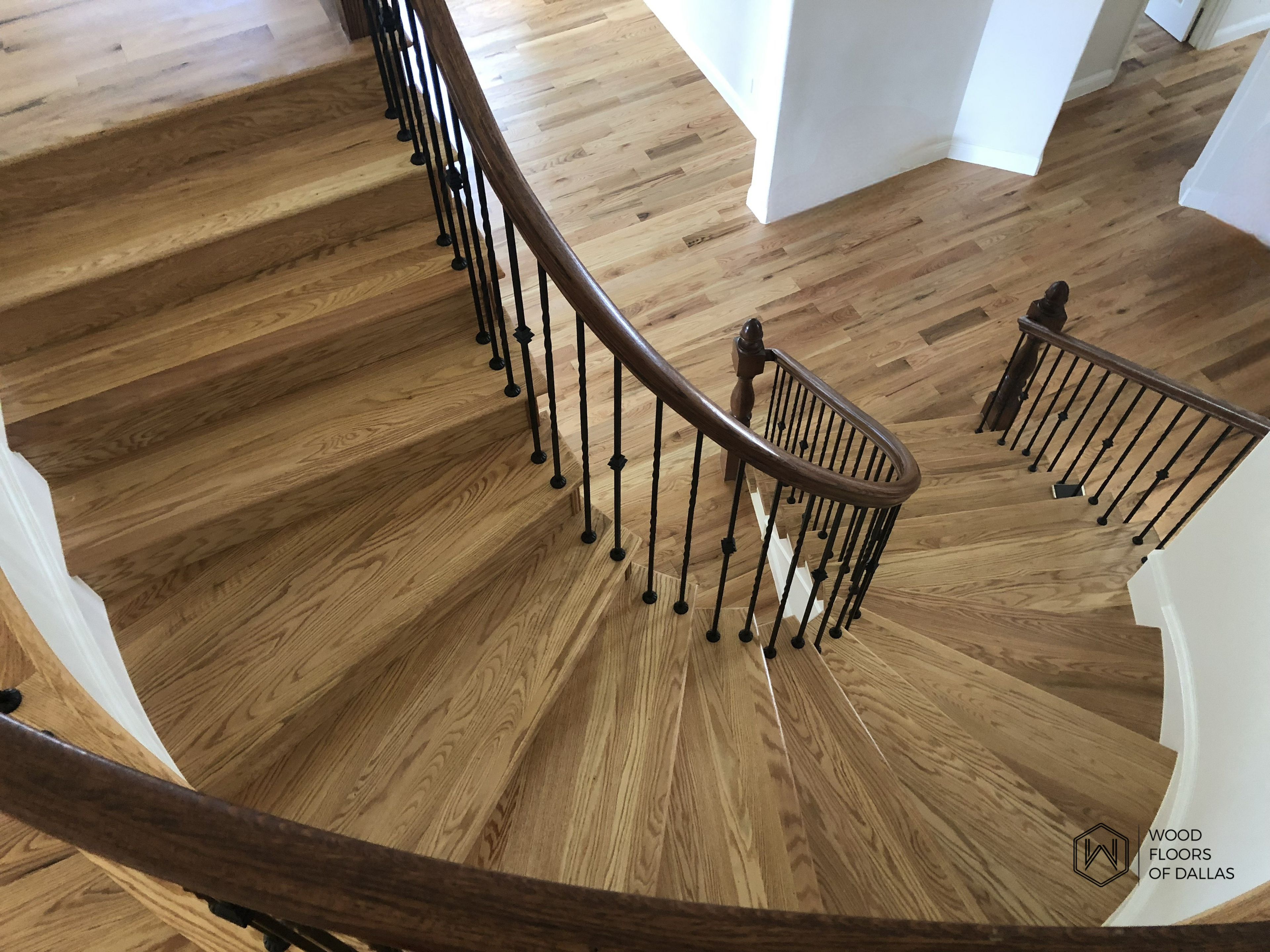
Hardwood Flooring
FAQ Engineered Hardwoods
Do you have to put underlayment under hardwood?
Yes, underlayment is recommended under hardwood floors to provide cushioning, sound absorption, and moisture protection in a floating installation. In a glue down installation, a roll on moiture barrier or moisture restant adhesive can be used to protect the flooring from excessive mositure in the substrate.
Does hardwood go directly on subfloor?
Yes, hardwood can be installed directly on a subfloor, provided that the subfloor is dry, level, and in good condition.
What is underneath hardwood floors?
Underneath hardwood floors, you typically find a subfloor, which can be made of plywood or oriented strand board (OSB), and in some cases, a layer of underlayment for insulation and soundproofing.
What are the cost differences between engineered and solid hardwood flooring?
Engineered hardwood flooring typically costs less than solid hardwood flooring, with prices generally ranging from $3 to $10 per square foot for engineered options, while solid hardwood can range from $5 to $15 per square foot or more, depending on the wood species and quality.
What are the disadvantages of engineered wood flooring
The disadvantages of engineered wood flooring include susceptibility to moisture damage, limited refinishing options compared to solid wood, potential for lower resale value, and the possibility of a less natural feel compared to solid hardwood.
How often should I replace engineered hardwood floors?
Engineered hardwood floors typically last between 20 to 30 years, but should be replaced sooner if they show significant wear or damage. Regular maintenance can extend their lifespan.
Does engineered hardwood last longer than hardwood?
No, solid hardwood typically lasts longer than engineered hardwood.
Do engineered wood floors scratch easily?
Engineered wood floors are generally more resistant to scratches than solid hardwood because of the factory controlled finishing process, but they can still be scratched. Regular maintenance and using protective pads under all furniture legs can help minimize scratches.
How often do you need to mop engineered hardwood floors?
You should mop engineered hardwood floors approximately once a month, or as needed, using a damp mop and a cleaner specifically designed for hardwood floors.
Does engineered wood have formaldehyde?
Some engineered wood products may contain formaldehyde, but many manufacturers offer formaldehyde-free options. It's important to check the product specifications and certifications before purchasing. Look for products labeled CARB 2 Compliant to ensure formaldehyde free emissions.
Does all engineered hardwood have formaldehyde?
Not all engineered hardwood contains formaldehyde, but some do. It's important to check for products labeled as low-emission or formaldehyde-free to ensure safety.
Does engineered flooring give off toxic fumes?
Engineered flooring can emit low levels of volatile organic compounds (VOCs), but many products are designed to meet strict low-emission standards and are considered safe for indoor use. Always check for certifications like CARB 2 or Greenguard for assurance.
What kind of wood has formaldehyde?
Certain types of engineered wood products, such as particleboard, plywood, and medium-density fiberboard (MDF), can contain formaldehyde, particularly if they are manufactured using adhesives that include urea-formaldehyde.
Which flooring has formaldehyde?
Laminate and engineered wood flooring can contain formaldehyde, particularly those made with urea-formaldehyde adhesives.
Does engineered hardwood need to acclimate?
Yes, engineered hardwood should acclimate before installation to adjust to the humidity and temperature of the environment.
Can engineered hardwood flooring acclimate in the box?
No, engineered hardwood flooring should not acclimate in the box. It should be unpacked and allowed to acclimate in the room where it will be installed. However many companies kiln dry their products to balance them before shipping. Areas with very low or very high relative humidity should make sure their products are evenly acclimated to the temperature and relative humidity of the home.
How soon can you walk on new engineered hardwood floors?
You can usually walk on new engineered hardwood floors 24 to 48 hours after installation.
How much acclimatisation is required with engineered wood?
Engineered wood floors typically require 48 to 72 hours of acclimatization before installation. Although many times the flooring is already in the required temperature and Relative Humidity range for installation immediately.
Should you seal engineered hardwood?
No, engineered hardwood is pre-finished and does not require any type of sealant.
What is the best finish for engineered wood flooring?
The best finish for engineered wood flooring is a polyurethane finish, particularly water-based polyurethane for enhanced durability and a clear appearance.
How do you waterproof engineered hardwood floors?
You cannot waterproof engineered floors prior to or after installation. It is a natural wood product that is not intended to be waterproof. Special engineered floors like Vossfloors.com or Woodura by Bjelin are made to be the most durable and water resistant real engineered hardwoods. While not being completely waterproof, they can be installed anywhere in the home including laundry and bathrooms. Sealing the edges during installation as well as preventing moisture from getting underneath the planks is the most important step to avoid potential water damage to any floor.
What not to use on engineered hardwood?
Avoid using excess water, steam mops, vinegar, harsh chemicals, abrasive cleaners, or wax on engineered hardwood floors. Do not use any product that contains "shine" or "oil" in the label.
How much does engineered wood expand?
Engineered wood typically expands and contracts between 1/16th and 1/8th inch for every 10 feet of length or width with a change in humidity and temperature.
What are the negatives of engineered wood?
Engineered wood can be susceptible to moisture damage, may not last as long as solid wood, can be difficult to repair or refinish, and often has a lower resale value compared to solid hardwood. Some engineered hardwoods with thick top layers can be refinished multiple times and hold their value just like solid hardwood does.
How much does engineered wood expand and contract?
Engineered wood typically expands and contracts between 1/16th and 1/8th inch for every 10 feet of length or width with a change in humidity and temperature.
Does engineered wood swell?
Yes, engineered wood can swell if it absorbs moisture.
How do you keep engineered wood floors from scratching?
To keep engineered wood floors from scratching, use area rugs in high-traffic areas, place felt pads under furniture legs, avoid walking on the floors with high heels, regularly clean the floors with a soft broom or vacuum with soft bristles, and use a damp cloth for spills instead of excessive water. Do not use a vacuum with a 'beater bar" as they are prone to cause damage to hardwods.
What are the negatives of engineered wood flooring?
Engineered wood flooring can be susceptible to water damage, has a limited lifespan compared to solid hardwood, may not be refinished as many times, and can be more expensive than some laminate options.
What is the most scratch resistant wood flooring?
The most scratch-resistant wood flooring is typically engineered hardwood with a high-performance finish, such as those with aluminum oxide technology. Additionally, species like oak and hickory are known for their durability. Both Voss Floors and Woodura by Bjelin offer the highest durability ratings of all engineered hardwoods.
How does engineered wood differ from solid hardwood?
Engineered wood consists of multiple layers of real wood veneers bonded together, providing better stability and moisture resistance, while solid hardwood is made from a single piece of wood and can be prone to warping and expansion due to humidity and temperature changes.
Can engineered wood floors be refinished?
Yes, engineered wood floors can be refinished, but the number of times they can be sanded and refinished depends on the thickness of the veneer layer. Wear or veneer layers 2mm or under should not be refinished.
What are the installation methods for engineered wood flooring?
The installation methods for engineered wood flooring include nail-down, glue-down, and floating installation.
Is engineered wood flooring suitable for basements or moisture-prone areas?
Yes, engineered wood flooring is suitable for basements or moisture-prone areas, as it is designed to withstand higher humidity levels better than solid hardwood.
How do I maintain and clean engineered wood floors?
To maintain and clean engineered wood floors, regularly sweep or vacuum to remove dirt and debris, use a damp (not wet) mop with a suitable wood floor cleaner, and avoid excessive water. Wipe up spills immediately and use felt pads under furniture to prevent scratches.
Can engineered wood flooring be installed over radiant heating systems?
Yes, some engineered wood flooring can be installed over radiant heating systems, but it's important to follow the manufacturer's guidelines for installation and ensure the heating system is properly maintained.
What is the difference between engineered hardwood and laminate flooring?
Engineered hardwood is made from real wood veneer over a plywood or high-density fiberboard base, providing a genuine wood appearance and feel, while laminate flooring is composed of a synthetic photographic layer that mimics the look of wood, typically made of compressed fiberboard.
How thick should the wear layer be on engineered wood flooring?
The wear layer on engineered wood flooring should be at least 2 mm thick for durability, with 3 mm to 5 mm being ideal for better performance. New products made specifically for long term durability and resistance to indentation have a thinner .6mm veneer. The thinner veneer utilizes the extreme strength of the core for durabillity, while the coating process fully encapsulates the hardwood layer providing additional strength and resistance to abrasion.
Can engineered wood flooring be installed over concrete slabs?
Yes, engineered wood flooring can be installed over concrete slabs.
Is engineered wood flooring safe for children and pets?
Yes, engineered wood flooring is safe for children and pets.
How does moisture affect engineered wood flooring?
Moisture can cause engineered wood flooring to expand or contract, leading to distortion, gaps, or buckling if not properly managed.
